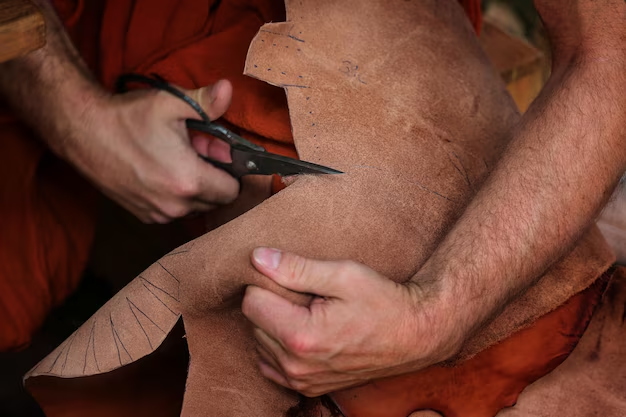The word zuschneidfelle may sound unfamiliar to many people, but in practical use, it refers to cuttable skins or hides that are designed for different purposes. They can be used in craft, fashion, upholstery, and even technical applications. People often choose zuschneidfelle because they are flexible, durable, and easy to shape for a wide range of needs. Whether you are a professional or a hobbyist, knowing more about zuschneidfelle helps you make the right choice for your project.
What Are Zuschneidfelle?
The term zuschneidfelle comes from German, and it simply means “cutting skins” or hides that can be trimmed to a required size. These hides are usually natural or synthetic materials that are processed so they can be cut easily without losing their strength. The idea is that you are not locked into one fixed shape. Instead, you can adjust zuschneidfelle to fit exactly what you need.
In many cases, zuschneidfelle are used by leather workers, tailors, crafters, or even technicians who need strong yet adaptable material. They can be large pieces of animal hide, artificial leather, or other flexible sheets that can be trimmed and shaped. The usefulness of zuschneidfelle lies in their balance of strength and versatility.
Common Uses of Zuschneidfelle
Zuschneidfelle are not limited to one single purpose. Their flexibility makes them valuable in many fields.
In clothing and fashion, zuschneidfelle are used for making jackets, coats, or decorative elements. Designers appreciate the ability to cut hides to exact sizes, allowing for both large and small creations. Upholstery is another major use. Furniture makers often rely on zuschneidfelle to cover chairs, sofas, or custom interior pieces. Since hides can be cut and shaped, they allow for smooth finishes and unique designs.
In crafting and hobby projects, zuschneidfelle are popular with people who create bags, wallets, or costume pieces. Because they are easy to cut, they make personalization simple. Technical industries also use zuschneidfelle, particularly where durable yet adjustable material is needed, such as in protective gear or padding.
The wide use of zuschneidfelle proves that they are not only traditional materials but also modern solutions for practical needs.
Materials and Quality of Zuschneidfelle
The material of zuschneidfelle is one of the most important things to understand before using them. Traditional zuschneidfelle are often made from natural animal hides such as sheep, goat, or cow. These offer strong durability and natural texture, making them ideal for clothing, upholstery, or accessories.
In addition to natural hides, modern zuschneidfelle also come in synthetic options. Artificial leather and other man-made materials are designed to mimic the look and feel of natural hides while being easier to produce and often more affordable. For some people, synthetic zuschneidfelle are preferred because they avoid animal products.
Quality is not just about the source material but also how it has been processed. Well-prepared zuschneidfelle are soft enough to cut without difficulty but strong enough to last for years. Poorly prepared ones may crack, tear, or lose their texture quickly. When choosing zuschneidfelle, it is useful to look at the finish, thickness, and flexibility. High-quality hides feel smooth, bend easily, and hold their color well.
Sizes and Customization Options
One of the key strengths of zuschneidfelle is that they are not restricted to fixed measurements. They are usually sold in large pieces or sheets, which can then be cut down to whatever size you need. This makes them highly adaptable for projects of all scales.
For small projects, you might only need a few smaller sections, while for larger upholstery or fashion items, bigger hides are more practical. The ability to trim zuschneidfelle also makes them perfect for custom projects. Instead of searching endlessly for a piece that fits, you can simply adjust the material to your desired dimensions.
Customization goes beyond size. Some zuschneidfelle can also be dyed, treated, or embossed to create different textures and appearances. This makes them valuable not only for function but also for design. A craftsperson can take a plain zuschneidfelle and turn it into a unique piece that suits personal taste or project requirements.
Care and Maintenance of Zuschneidfelle
To keep zuschneidfelle in good condition, regular care is essential. Natural hides need to be kept clean and free from excessive moisture. If exposed to water for long periods, they can stiffen or lose flexibility. Dust and dirt should be gently brushed or wiped off with a soft cloth.
For long-term use, conditioning is important. Natural zuschneidfelle often benefit from leather conditioners that keep the material soft and prevent cracks. Synthetic options may not need as much treatment, but they should still be cleaned carefully to avoid damage.
Storage also plays a role in maintaining zuschneidfelle. They should be kept in cool, dry places, away from direct sunlight. Folding them too tightly may leave permanent creases, so it is often better to roll them loosely. With proper care, zuschneidfelle can last for many years while keeping their original quality.
Choosing the Right Zuschneidfelle
Selecting the best zuschneidfelle depends on your specific project. If you need material for fashion or clothing, a softer, more flexible hide is usually the best choice. For upholstery, thicker and stronger zuschneidfelle are more suitable because they must endure regular use.
Budget is also a factor. Natural hides are often more expensive, but they come with unmatched texture and durability. Synthetic alternatives are more affordable and sometimes more practical for large projects or for people who prefer vegan-friendly options.
Another thing to consider is the look and finish. Zuschneidfelle come in different shades, patterns, and textures. For visible items like jackets or bags, appearance is just as important as durability. On the other hand, for technical or hidden uses, function may matter more than looks.
The right choice is always the one that balances quality, size, appearance, and price in a way that fits your needs.
Conclusion
Zuschneidfelle are versatile materials that have remained useful for generations. From fashion and upholstery to technical work and personal crafting, their flexibility makes them an important choice for many people. By understanding their materials, uses, sizes, and care, you can make informed decisions when choosing the right zuschneidfelle for your project. With the right selection and proper maintenance, zuschneidfelle provide long-lasting value, combining tradition and modern utility in one material.
FAQs
1. What does zuschneidfelle mean?
Zuschneidfelle is a German word that refers to hides or skins that can be cut and shaped for different uses.
2. Are zuschneidfelle available in different materials?
Yes. They can be natural animal hides like sheep or cow, as well as synthetic materials that mimic the texture of leather.
3. How do I clean and care for zuschneidfelle?
They should be kept dry, cleaned gently, and conditioned if natural. Synthetic versions need less care but should still be stored properly.
4. Can zuschneidfelle be customized for special use?
Absolutely. They can be cut, dyed, or treated to fit specific designs, sizes, and creative needs.




